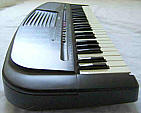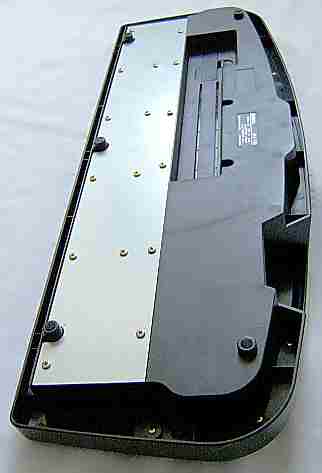| keyboard with interesting lo-fi wavetable sounds & percussion |
This keyboard from 1993 (embossed case date) seems to be the closest relative to the Casio SA series that has real (not fixed key) accompaniment and 49 keys.
 |
 |
 The
case of this thing is an odd construction that is awkward to dismantle
due to lots of screws. Odd is also that the cipher buttons are of plastic,
while all the other round buttons in the same row are of rubber. The main
PCB is very small and corresponds to Casio
SA series instruments. Also the round speaker (gladly labelled "Center
Speaker System") is much smaller than its grill.
The
case of this thing is an odd construction that is awkward to dismantle
due to lots of screws. Odd is also that the cipher buttons are of plastic,
while all the other round buttons in the same row are of rubber. The main
PCB is very small and corresponds to Casio
SA series instruments. Also the round speaker (gladly labelled "Center
Speaker System") is much smaller than its grill.
The 100 preset sounds resemble much Casio SA-1 (see there) although they are in a different order (sorted by instrument groups) and some sound different (often worse). With each sound the 2nd suboscillator (often used for chorus effect) can be switched on or off with the "tone bank poly/ texture" button; with some sounds it is on by default, with others off. The preset sounds "honky- tonk piano", "typewriter", "gamelan", "afro percussion", "ethnic percussion", "wadaiko", "conga/ agogo", "cowbell/ clave" have been replaced with "funky clavi", "motorcycle", "bass/ vibraphone", "bass/ synth- lead", "bass/ elec- organ", "strings/ brass", "chorus/ bells", "brass/ synth- reed". The "funky clavi" is a bright picked string without sustain (variation: chorus + 2 echoes with weak reverb after key release). The "motorcycle" motor pitch goes up and restarts low (only 1 note pitch, with long sustain). The "piano" starts here with suboscillator off (no chorus). The squawky "elec organ" here is a strong vibrato, comes up without chorus and sounds a bit duller and more boring. The "chorus" now sounds more like a human "ah" voice than a flute. The "sitar" howls here brassy and sounds like "fantasy" on SA-1 (more realistic?, with chorus), while "fantasy" howls less (but still very sitar- like). The "cosmic sound" sounds different and more complex here and has 4 different key splits (2 resemble howling shortwave radio noises, 2 chirp metallic and howl slowly up and down; all employ much phasing effects). Also the "laser beam" has 4 different key splits now. Many bass sounds have now a key split with drum kit mode percussion in the lowest keyboard octave.
The percussion uses low resolution samples with partly even lower(!) sound quality than Casio SA-1 and the rhythms here also don't employ phasing effects anymore. The drums are duller and e.g. the hihat of the "rock drum" buzzes ridiculously short looped (like a Yamaha PSS-7 sound) and simply stops at the end without any decay envelope. Although these trashy ghettoblaster drums were intended as acoustic samples (except synth toms), they make nice tekkno noises. The CPU number "M6387-13" is very close to the "M6387-01" of the small Casio SA-1 and both have only 30 pins, thus my theory is that Casio re-used the same basic CPU design, and instead of adding more ROM memory to store the 100 accompaniments, they simply reduced the percussion sample resolution to free storage space. Also the fill-in button in many rhythms only plays a short and simple percussion sound with a long pause instead of inserting a complex and memory consuming drum solo pattern. The rhythm tempo can be set very low, but not extremely high.
Interesting is that the Casio MA-130 has many unusual accompaniments of partly very old music styles like 1950th rock'n'roll variants, "doo- wop", "30's pop", 4x "60's pop" and nice old 1970th disco and 1980th synth pop styles those sound quite fresh by their digital lo-fi appeal. The "accomp volume" slider has only 5 digital steps (4 volumes and off) and reduces the sample bit resolution of rhythm and accompaniment badly which truncates the decay phase of envelopes, but this can be also regarded as a sound effect. Unfortunately the switch responds slowly (polled with about 4Hz), which limits its use as a realtime sound control. Annoying is that any successful button press makes a quiet woodblock noise, which disturbs live play. Annoying is also that the accompaniment of this modern Casio keyboard reacts only on a few standard establishment chords and completely ignores anything else, while older Casios (e.g. the great Casio CT-410V) were capable to transform any disharmonic keys combinations into complex accompaniment patterns. Here Casio began the same annoyingly stubborn programmed 100 presets nonsense like Yamaha with e.g. their PSS-390 (see there). Also annoying is that the accompaniment eats so much polyphony that only monophonic melody play is possible. Only by deactivating the 2nd suboscillator a 2nd voice can be played (but with significantly reduced sound complexity), while older Casios always reserved at least 4 polyphony channels for the main voice.
The demo music is a complex arranged jazzy bigband medley consisting of 3 melodies:
| removal of these screws voids warranty... | ||
 |
||
|
|